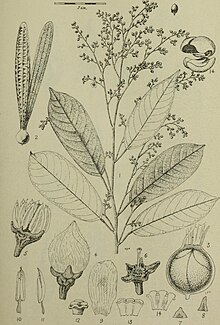Cotylelobium melanoxylon is a tree in the family Dipterocarpaceae. The specific epithet melanoxylon means "black wood", referring to the dark colour of the tree's wood. It was first described by Joseph Dalton Hooker in 1860 as Anisoptera melanoxylon and transferred to Cotylelobium by Jean Baptiste Louis Pierre in 1889. It is the provincial tree of Surat Thani Province, Thailand.

Anisoptera costata is an endangered species of plant in the family Dipterocarpaceae. The specific epithet costata means "ribbed", referring to the prominent venation of the leaf blade. A huge emergent tree up to 65 m high, it is found in evergreen and semi-evergreen lowland tropical seasonal forests of Indo-Burma and in mixed dipterocarp forests of Malesia.
Anisoptera grossivenia is a tree in the family Dipterocarpaceae, native to Borneo. The specific epithet grossivenia means "veined like unripe fig", referring to the purple veins of the leaf.
Anisoptera marginata is a tree in the family Dipterocarpaceae. The specific epithet marginata means "bordered", referring to the leaf veins.
Anisoptera reticulata is a tree in the family Dipterocarpaceae. The specific epithet reticulata means "netted", referring to the leaf veins.
Hopea altocollina is a tree in the family Dipterocarpaceae, native to Borneo. The specific epithet altocollina means "high hills", referring to the species' habitat.

Hopea beccariana is a species of tree in the family Dipterocarpaceae. It is named for the Italian botanist Odoardo Beccari.
Hopea griffithii is a tree in the family Dipterocarpaceae. It is named for the British doctor and naturalist William Griffith.
Hopea latifolia is a tree in the family Dipterocarpaceae. The specific epithet latifolia means "wide leaf".
Hopea micrantha is a tree in the family Dipterocarpaceae. The specific epithet micrantha means "small flower".
Hopea pedicellata is a tree in the family Dipterocarpaceae. The specific epithet pedicellata, refers to the species' prominent pedicel.
Hopea pentanervia is a tree in the family Dipterocarpaceae, native to Borneo. The specific epithet pentanervia means "five-nerved", referring to the species' five pairs of leaf veins.
Hopea sangal is a tree in the family Dipterocarpaceae. It is native to tropical Asia.
Hopea semicuneata is a tree in the family Dipterocarpaceae. The specific epithet semicuneata means "half wedge-shaped", referring to the leaf base.
Cotylelobium lanceolatum is a tree in the family Dipterocarpaceae. The specific epithet lanceolatum means "lance-like", referring to the shape of the leaf.
Hopea cernua is a tree in the family Dipterocarpaceae. The specific epithet cernua means "slightly drooping", referring to the flowers.
Hopea dryobalanoides is a tree in the family Dipterocarpaceae. The specific epithet dryobalanoides means "resembling Dryobalanops", referring to that genus of trees and particularly their leaf veins.
Hopea tenuinervula is a tree in the family Dipterocarpaceae, native to Borneo. The specific epithet tenuinervula means "slender nerve", referring to the leaf veins.
Hopea treubii is a tree in the family Dipterocarpaceae, native to Borneo. It is named for the Dutch botanist Melchior Treub.
Shorea coriacea is a tree in the family Dipterocarpaceae, native to Borneo. The specific epithet coriacea means "leathery" and refers to the leaves.



